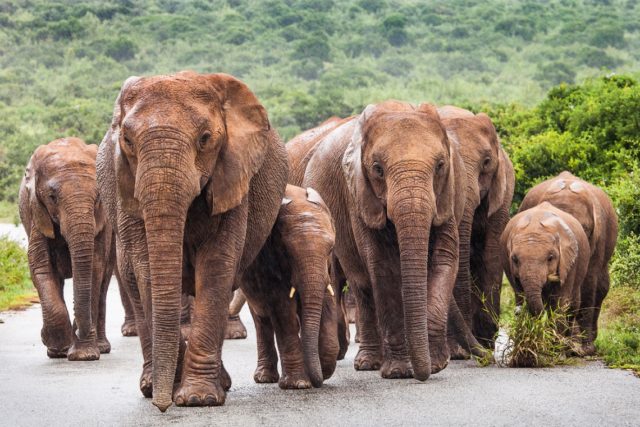
The African elephant is the largest existing land animal in the world, which makes them very easy to sight in the many animal reserves and national parks that they can be found. In Uganda, you will find several of these elephants in national parks such as Semuliki, Queen Elizabeth and Bwindi, while in Rwanda they can be found in the Akagera National Park.
Elephants are amazing creatures and these are some of the known facts about them.
There are two types of elephants
In Uganda, you will find two types of elephants in the wild. However, the distinction is not quite obvious till you move close enough to look at them. Savannah elephants are slightly larger than their forest counterparts and on the other hand the latter are usually grey in colour and live mostly in the jungles and forests such as the Bwindi impenetrable forests.
Intelligence
Elephants are known to have a high intellectual quotient, almost close that of human beings. This makes them one of the most intelligent animal species in the world. Their brain is believed to be formed in the same way as that of a human, with a total of over 300 billion neurons and general connectivity.
The elephant brain is also big in size compared to other animals even though the Asian elephant is believed to be more intelligent than the African one.
Lifespan
African elephants can live up to 80 years — especially when not in captivity — compared to their Asian cousins whose lifespan is estimated to be 48 years.
Gestation period
Of all mammals, elephants have the longest gestation period of approximately 22 months. The long developmental period allows the fetus to mature and once the calf is born, it stands and starts walking on its own. Just like humans, elephants raise their young and a new calf is always at the centre of the herd to avoid attacks. The calves are fed on milk for the first few months and in the absence of its mother, the calf is adopted and raised by the other cows (female elephants).
Feeding
Elephants are herbivorous animals and feed according to their different locations. In Uganda, the forest and savannah elephants feed on leaves and grass close to their habitats. They use their trunks and tusks to forage for food.
Family
Elephants, especially females, live among their families compared to the males. They move in herds led by the oldest female known as a matriarch who provides direction and decision for the young herd members. Once the matriarch dies, she is succeeded by her eldest daughter to lead the group. The bulls (male elephants) usually separate from their families when they hit puberty and tend to live with other bulls or live alone and can only move when looking for a mate.
Emotions
The elephant species displays some similar emotional traits as those of human beings. They are known to show compassion and empathy to others, especially in situations where one of them is ailing. They take care of their old by feeding them and usually bury their dead by digging a hole and covering it with leaves or mud.
Ears
Their huge ears are a huge distinctive body part that is usually used to differentiate an African elephant from an Asian one. Asian elephants have small ears while the African elephants have big ears, which they use to fan out the savannah heat. The ears contain blood veins known as capillaries that transport blood through the ear and helps release excess body heat by flapping.
Tusks and trunk
Elephants’ tusks are a huge part of their life and you will find that some elephants are either left-tusked or right-tusked depending on what tusk they use the most. You cannot remove an elephant’s tusk without bringing harm to it, since they usually contain veins that go up to their skulls.
The trunk is a boneless long muscle that serves as both an upper lip and nose for the animal. They are used for several things, including breathing, feeding and touching other elephants to show emotions and vocal communication.
Elephants are some of the most endangered animals in Uganda and the whole of East Africa, due to the rise in illegal ivory trade carried out in national parks.









